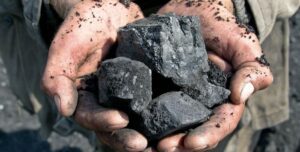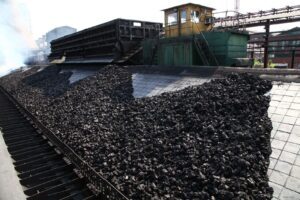
Ukraine in 2022 reduced the export of coke and semi-coke in volume terms by 98% compared to the previous year – up to 3.856 thousand tons, in December export was not carried out.
According to statistics released by the State Customs Service (SCS), exports of coke and semi-coke in monetary terms fell by 97.6% to $1.011 million over the period.
The main export was carried out in Hungary (42.63% of supplies in monetary terms), Georgia (37.69%) and Turkey (17.41%).
Ukraine imported 359.192 thousand tons of coke and semi-coke in 2022, down 54.5% compared to 2021. In monetary terms, imports decreased by 50.3% to $174.499 million.
Imports came mainly from Russia (43.43% of supplies in monetary terms, before the war), Poland (30.07%) and the Czech Republic (13.15%).
As reported, Ukraine in 2021 increased the export of coke and semi-coke in volume terms by 3.3 times compared to 2020 – up to 194.535 thousand tons. In monetary terms, export of coke and semi-coke during this period rose in 4.8 times – up to $ 41.838 million. The main export was carried out in Kazakhstan (29.03% in monetary terms), Turkey (20.06%) and Algeria (15.77%).
Ukraine imported 789.903 thousand tons of coke and semi-coke in 2021, which is 2.1 times more than in 2020. In monetary terms, imports increased 4.3 times – up to $351.238 million. Imports were carried out mainly from Russia (65.48% of supplies in monetary terms), the Czech Republic (20%) and Poland (8.45%).
As a result of the war, a number of mines and coke and chemical plants were located in territories temporarily outside of Ukraine’s control.

In January-November 2022, the coke-making division of Kametstal (formerly Dniprovsky Coke Chemical Plant, Kamenskoye, Dnipropetrovsk Region) of Metinvest Mining and Metallurgical Group reduced its output of metallurgical coke by 27.7% year-on-year, to 365 thousand tons.
As a company representative told Interfax-Ukraine, in November the company produced 30 thousand tons of metallurgical coke.
Meanwhile, in January-November 2022 the gross coke output at 6% moisture amounted to 420,000 tons, including 34,000 tons in November.
In 11 months-2021, the plant produced 505 thousand tons of coke, including 43 thousand tons in November.
In 11 months 2022 the plant was supplied 581 thousand tons of coals and concentrate, including 490 thousand tons of domestic coals, 36 thousand tons from the Russian Federation (before the war) and 55 thousand tons from the United States. In November, 56,000 tonnes of coking coal of Ukrainian production were supplied.
As reported, holding plants in Ukraine for 11M-2022 decreased the production of gross coke 6% moisture by 58.1% compared to the same period in 2021 – up to 3.66 million tons. At the same time in November, 235 thousand tons of gross coke, including metallurgical coke – 204 thousand tons, during this period production of metallurgical coke was 3.14 million tons.
Currently, Yuzhkoks, Kametstal, DMZ (“Dneprokoks”), Zaporizhkoks and coke-chemical production at ArcelorMittal Kryvyi Rih are in operation.
During 11 months of 2022, 4.254 million tons of coal concentrate was supplied to domestic coke plants (11 months-2021 – 11.834 million tons), including Ukrainian production – 2.853 million tons, 623.9 thousand tons were imported from Russia (before war), 65.4 thousand tons from Kazakhstan (before war), Poland – 36.3 thousand tons, Czech Republic – 38.8 thousand tons, USA – 448.6 thousand tons and Australia – 187.3 thousand tons. Including 308 thousand tons of concentrate supplied in November, of which Ukrainian production – 299 thousand tons.
Ukraine in 2021 decreased coke output by 1.3% compared to 2020 – down to 9.543 million tons.
“Kametstal” was created on the basis of PJSC “Dneprovskiy Coke Chemical Plant” (DKHZ) and the CEC of PJSC “Dneprovskiy Metallurgical Plant” (DMK).
According to the report of the parent company of Metinvest Group for 2020, Metinvest B.V. (Netherlands) owned 100% of DKHZ shares.

krainian coke and chemical plants (CCP) in January-November this year reduced production of gross coke with 6% moisture by 58.1% compared to the same period last year – to 3.66 million tons.
As reported to Interfax-Ukraine by Anatoliy Starovoyt, director general of Ukrkoks association of coke-chemical enterprises (Dnipro) in November they produced 235,000 tonnes of gross coke, including 204,000 tonnes of metallurgical coke,
According to him, over 11 months of 2022, production of metallurgical coke amounted to 3.14 million tons.
Currently, Yuzhkoks, Kametstal (formerly DKHZ), DMZ (Dneprokoks), Zaporizhkoks and coke-chemical production at ArcelorMittal Kryvyi Rih are operating.
The general director also said that during 11 months of 2022, the domestic coke plants supplied 4.254 million tons of coal concentrate (11M-2021 – 11.834 million tons), including Ukrainian production – 2.853 million tons, from Russia imported (before the war) 623.9 thou. tons, from Kazakhstan (before the war) – 65.4 thousand tons, Poland – 36.3 thousand tons, the Czech Republic – 38.8 thousand tons, the United States – 448.6 thousand tons and Australia – 187.3 thousand tons. Including 308 thousand tons of concentrate supplied in November, including 299 thousand tons of Ukrainian production.
As reported, Ukraine in 2021 decreased coke output by 1.3% compared with 2020 – to 9.543 million tons.

Ukraine in January-November this year, exports of coke and semi-coke in physical terms decreased by 98% compared to the same period last year to 3,856 thousand tons.
According to statistics released by the State Customs Service (SCS), in monetary terms, exports of coke and semi-coke during this period fell by 97.6% to $1.011 million.
Ukraine imported 340,451 thousand tons of coke and semi-coke in January-November 2022, down 50.4% from January-November 2021. In monetary terms, imports fell by 42.1% to $168.885 million.
As reported, Ukraine in 2021 increased the export of coke and semi-coke in volume terms by 3.3 times compared to 2020 – up to 194.535 thousand tons. In monetary terms, export of coke and semi-coke during this period rose in 4.8 times – up to $ 41.838 million. The main exports were carried out in Kazakhstan (29.03% in monetary terms), Turkey (20.06%) and Algeria (15.77%).
Ukraine imported 789.903 thousand tons of coke and semi-coke last year, which is 2.1 times more than in 2020. In monetary terms, imports increased 4.3 times – up to $351.238 million. Imports were carried out mainly from Russia (65.48% of supplies in monetary terms), the Czech Republic (20%) and Poland (8.45%).
As a result of the war, a number of mines and coke and chemical plants were located in territories temporarily outside of Ukraine’s control.

Ukraine in January-September of this year reduced the export of coke and semi-coke in kind by 98% compared to the same period last year – up to 3.697 thousand tons.
According to statistics published by the State Customs Service (STS), in monetary terms, the export of coke and semi-coke over this period fell by 97.5% to $987,000.
At the same time, the main exports were to Hungary (43.62% in monetary terms), Georgia (38.56%) and Turkey (17.81%).
Ukraine in January-September 2022 imported 331.941 thousand tons of coke and semi-coke, which is 30.8% less compared to January-September 2021. In monetary terms, imports decreased by 11.2% – to $164.592 million. Imports were carried out mainly from the Russian Federation (46.04% of deliveries in monetary terms), Poland (29.94%) and the Czech Republic (13.87%).
As reported, Ukraine in 2021 increased the export of coke and semi-coke in physical terms by 3.3 times compared to 2020 – up to 194.535 thousand tons. In monetary terms, the export of coke and semi-coke over this period increased by 4.8 times – up to $41.838 million. The main exports were to Kazakhstan (29.03% of deliveries in monetary terms), Turkey (20.06%) and Algeria %).
Ukraine imported 789,903 thousand tons of coke and semi-coke last year, which is 2.1 times more compared to 2020. In monetary terms, imports increased 4.3 times – up to $351.238 million. Imports were carried out mainly from the Russian Federation (65.48% of deliveries in monetary terms), the Czech Republic (20%) and Poland (8.45%).
As a result of hostilities in eastern Ukraine, a number of mines and coking plants ended up in territories temporarily not controlled by Ukraine.

The coke-chemical division of the Kametstal plant of the Metinvest mining and metallurgical group (former Dneprovsky Coke Plant, DKHZ, Kamenskoye, Dnepropetrovsk Region) reduced the production of metallurgical coke by 32.4% in January-July this year compared to with the same period last year – up to 227.3 thousand tons.
As a representative of the company told the Interfax-Ukraine agency, in July the enterprise produced 25.8 thousand tons of metallurgical coke.
At the same time, in January-July 2022, the output of 6% moisture gross coke amounted to 263.1 thousand tons, including 30 thousand tons in July.
The plant produced 336 thousand tons of coke in seven months-2021, including 48 thousand tons in July-2021.
During the specified period, the enterprise was supplied with 266.5 thousand tons of domestic coal, 36 thousand tons from Russia (before the war) and 54 thousand tons from the USA. In July, 37,000 tons of domestically produced coking coal were delivered.
As reported, in January-July this year, Ukrainian Coke Plants reduced the production of 6% moisture gross coke by 53.4% compared to the same period last year – to 2.682 million tons, in July 224.4 thousand tons were produced. Including for 7 months-2022, the production of metallurgical coke amounted to 2.3 million tons, in July – 191.8 thousand tons.
Ukraine in 2021 reduced the production of coke by 1.3% compared to 2020 – to 9.543 million tons.
Kametstal was created on the basis of PJSC “Dneprovsky Coke and Chemical Plant” (DKKHZ) and the CEC of PJSC “Dneprovsky Metallurgical Plant” (DMK).
According to the report of the parent company of the Metinvest group for 2020, Metinvest B.V. (Netherlands) owned 100% of the shares of DKHZ.